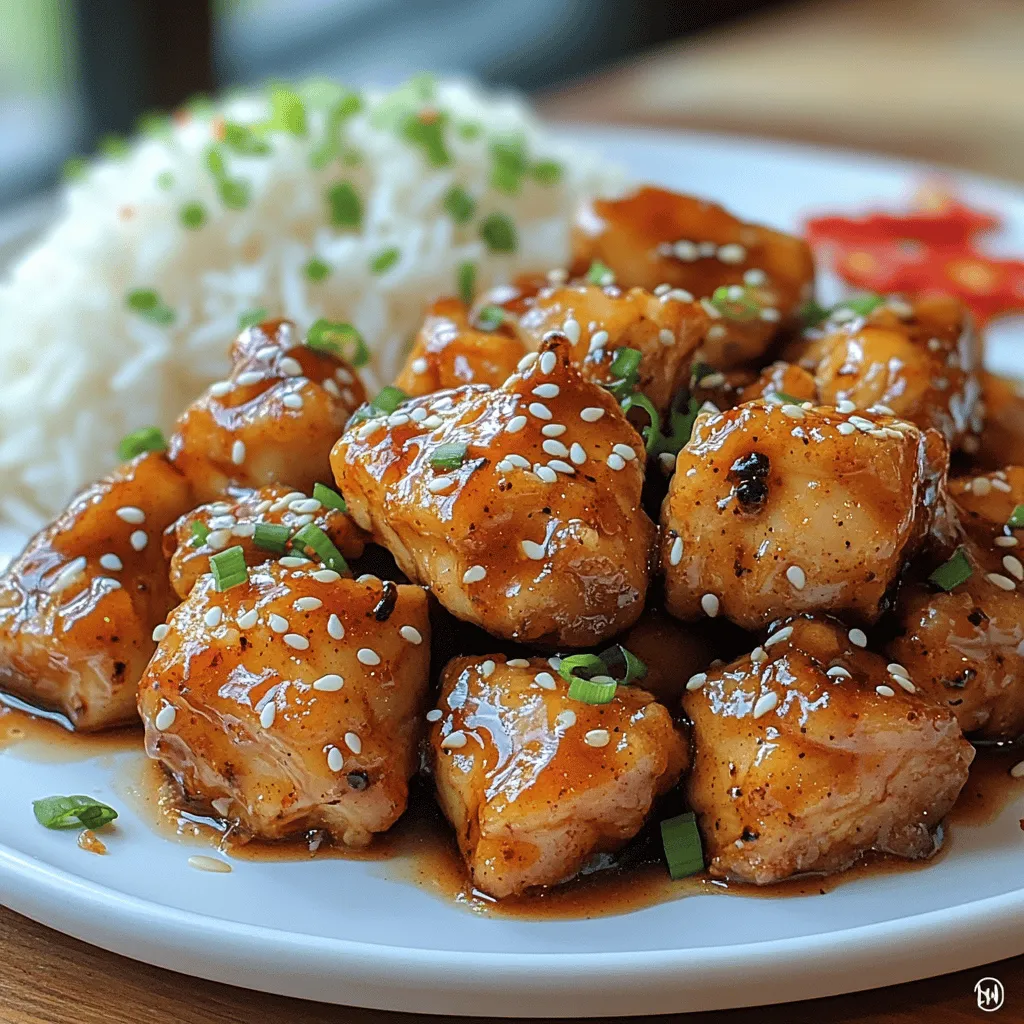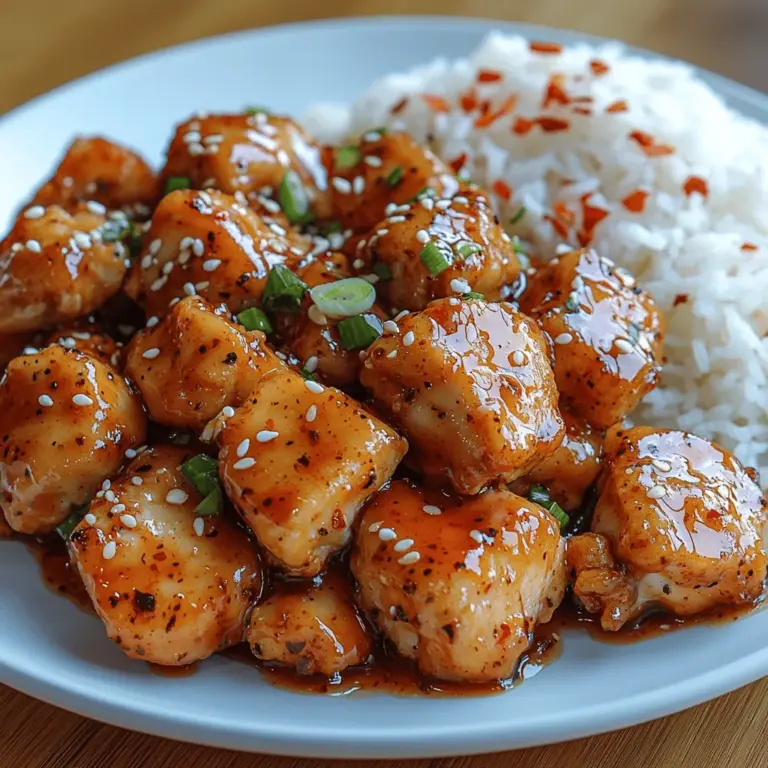Introduction
General Tso’s Chicken is not just a dish; it’s a phenomenon in the realm of Chinese cuisine. Originating from the culinary traditions of Hunan province in China, this dish has become a staple in American Chinese restaurants, beloved for its perfect balance of sweet, savory, and spicy flavors. The crunchy texture of the chicken, combined with a rich, tangy sauce, makes it a favorite among food lovers, transcending cultural boundaries and earning a rightful place on menus across the United States.
As you step into your kitchen to recreate this iconic dish, you’ll find that making General Tso’s Chicken at home is not only possible but also rewarding. Our homemade version of General Tso’s Chicken Delight captures the essence of the traditional recipe while simplifying the preparation process. With a few key ingredients and straightforward steps, you’ll be able to serve up a plate of this flavorful dish in no time. Let’s delve into the elements that make this recipe shine and learn how to achieve the perfect balance of flavors and textures.
Understanding the Ingredients
Every great dish starts with quality ingredients, and General Tso’s Chicken is no exception. Let’s break down the essential components that come together to create this delightful meal.
Chicken Marinade
Marinating chicken is a crucial step in enhancing both flavor and tenderness. The marinade infuses the meat with savory notes while ensuring it remains juicy during cooking. For our General Tso’s Chicken, the marinade consists of three main ingredients:
1. Soy Sauce: This staple of Asian cuisine provides a salty, umami-rich flavor that penetrates the chicken.
2. Rice Wine: Adding depth, this ingredient enhances the dish’s authenticity and contributes to the overall flavor profile.
3. Cornstarch: This ingredient serves a dual purpose. It not only helps to tenderize the chicken but also forms a light coating that aids in achieving the perfect crispy texture during frying.
By allowing the chicken to marinate for at least 30 minutes, you enable these flavors to meld, resulting in a dish that’s bursting with taste.
Coating
The crispy coating is one of the defining features of General Tso’s Chicken. A well-executed coating not only adds texture but also helps lock in moisture. For this recipe, the coating consists of:
– All-Purpose Flour: This forms the base of the coating and gives the chicken its crunchy exterior.
– Cornstarch: In addition to its use in the marinade, cornstarch is essential for achieving an extra crunch when fried.
– Baking Powder: This ingredient helps the batter puff up, creating a light and airy texture.
– Salt and Black Pepper: These seasonings elevate the flavor of the coating, ensuring it complements the chicken perfectly.
The combination of these ingredients is essential for achieving that signature crispiness that makes every bite satisfying.
Sauce
The sauce is truly the heart of General Tso’s Chicken, defining its taste and providing the signature glossy finish. Here’s a detailed look at the sauce ingredients:
– Soy Sauce: Again, soy sauce takes center stage, providing the salty foundation for the sauce.
– Hoisin Sauce: This thick, sweet sauce adds complexity and a hint of sweetness, balancing the overall flavor.
– Rice Vinegar: Introducing acidity, rice vinegar cuts through the richness of the sauce and brightens the dish.
– Sugar: Enhancing sweetness, sugar works in harmony with the other ingredients to create a well-rounded sauce.
– Sesame Oil: This oil adds a nutty aroma and flavor, enriching the dish’s overall profile.
– Garlic and Ginger: Freshly minced garlic and ginger are essential for providing aromatic depth and a hint of spice.
– Red Pepper Flakes: These add a kick of heat, allowing you to adjust the spice level to your preference.
Each of these components plays a vital role in crafting the rich, complex flavor that General Tso’s Chicken is known for.
Stir-Frying Essentials
To achieve the perfect stir-fry, choosing the right oil and garnishes is crucial. For frying the chicken, vegetable oil is preferred due to its high smoke point, which ensures that the chicken cooks evenly and achieves a golden-brown color. Additionally, garnishing with green onions and sesame seeds not only adds visual appeal but also enhances the dish’s flavor and texture.
Step-by-Step Instructions
Now that we have a solid understanding of the ingredients, let’s dive into the preparation process. Follow these detailed steps to ensure your General Tso’s Chicken Delight turns out perfectly every time.
Marinating the Chicken
1. Prepare the Chicken: Begin by cutting boneless, skinless chicken breasts into bite-sized pieces. This allows for even cooking and optimal flavor absorption.
2. Mix the Marinade: In a bowl, combine 3 tablespoons of soy sauce, 2 tablespoons of rice wine, and 1 tablespoon of cornstarch. Whisk until the cornstarch is fully dissolved.
3. Marinate the Chicken: Add the chicken pieces to the marinade, ensuring they are well coated. Cover the bowl and let it marinate in the refrigerator for at least 30 minutes. For even better results, consider marinating for up to 2 hours.
Preparing the Batter
1. Combine Dry Ingredients: In another bowl, mix 1 cup of all-purpose flour, ½ cup of cornstarch, 1 teaspoon of baking powder, ½ teaspoon of salt, and ½ teaspoon of black pepper. Whisk the ingredients together until well incorporated.
2. Add Water: Gradually add cold water to the dry mixture, stirring until you achieve a smooth, thick batter. The consistency should be thick enough to coat the back of a spoon but still pourable. If it’s too thick, add a little more water; if too thin, add a bit more flour.
Coating the Chicken
1. Heat the Oil: In a large, deep skillet or wok, heat about 1 inch of vegetable oil over medium-high heat. To test if the oil is hot enough, drop a small amount of batter into the oil; it should sizzle and rise to the surface.
2. Coat the Chicken: Remove the marinated chicken from the refrigerator. Dip each piece into the batter, ensuring it is thoroughly coated.
3. Fry the Chicken: Carefully place the coated chicken pieces into the hot oil, being sure not to overcrowd the pan. Fry in batches if necessary. Cook for 4-5 minutes or until the chicken is golden brown and crispy. Use a slotted spoon to remove the chicken and drain it on a plate lined with paper towels.
By following these steps, you’ll set the foundation for a delicious homemade General Tso’s Chicken Delight. Stay tuned for the next part, where we’ll explore how to create the sauce and bring everything together for a truly delightful meal.

Tips for Evenly Coating the Chicken Pieces for Optimal Crispiness
Achieving that perfect crunch in General Tso’s Chicken starts with how you coat the chicken. Here are some effective tips to ensure that each piece is evenly coated for maximum crispiness:
1. Use the Right Flour: Opt for a combination of all-purpose flour and cornstarch. The cornstarch creates a lighter batter that crisps up beautifully when fried.
2. Dry the Chicken Thoroughly: Before coating the chicken, pat it dry with paper towels. Excess moisture can lead to a soggy coating, so this step is crucial.
3. Dredging Technique: Instead of dropping all the chicken pieces into the flour mixture at once, work in small batches. Toss each piece in the flour mix until fully coated, shaking off the excess. This ensures an even coating and prevents clumping.
4. Double Coating: For an extra crunch, consider double-coating the chicken. First, coat the pieces in the flour-cornstarch mix, dip them in a beaten egg, and then coat them again in the flour mixture.
5. Let it Rest: Allow the coated chicken to sit for about 10-15 minutes before frying. This helps the coating adhere better during cooking.
Frying the Chicken
Frying the chicken is the most critical step in achieving that crispy texture. Follow these techniques to ensure you get a golden-brown finish and fry safely:
1. Heat the Oil Properly: Use a deep, heavy-bottomed pot or a deep fryer. Heat oil to around 350°F (175°C). A candy or frying thermometer can help you monitor the temperature.
2. Fry in Batches: Avoid overcrowding the pot, as this can lower the oil temperature and cause the chicken to steam rather than fry. Fry in small batches, allowing enough space for the pieces to bubble and cook evenly.
3. Monitor Cooking Time: Fry the chicken for about 4-5 minutes per batch, or until golden brown. Adjust the time according to the size of the pieces, ensuring they reach an internal temperature of 165°F (74°C).
4. Safety Tips: Use long-handled tongs to avoid splatters, and ensure there’s a lid nearby for emergencies. Keep a close eye on the pot to prevent the oil from overheating or smoking.
5. Drain Excess Oil: Once fried, transfer the chicken to a plate lined with paper towels to absorb excess oil. This step keeps your chicken crispy and not greasy.
Making the Sauce
The sauce is what brings General Tso’s Chicken to life with its distinct flavor profile. Follow this step-by-step guide to prepare the sauce and achieve a perfect balance of flavors:
1. Ingredients: Gather the following ingredients for the sauce:
– 1/4 cup soy sauce
– 2 tablespoons rice vinegar
– 1 tablespoon hoisin sauce
– 1 tablespoon sugar (or honey)
– 1 teaspoon sesame oil
– 2 teaspoons cornstarch mixed with 2 tablespoons water (for thickening)
– 2-3 dried red chilies (adjust based on your heat preference)
– 2 cloves garlic, minced
– 1-inch piece of ginger, grated
2. Combine Ingredients: In a bowl, whisk together the soy sauce, rice vinegar, hoisin sauce, sugar, and sesame oil until the sugar is dissolved.
3. Cook the Sauce: In a saucepan over medium heat, sauté the minced garlic and grated ginger for about a minute until fragrant. Add in the whisked sauce mixture and the dried red chilies. Let it simmer for 2-3 minutes.
4. Thicken the Sauce: Gradually stir in the cornstarch slurry (cornstarch mixed with water). Continue to cook, stirring frequently until the sauce thickens to your desired consistency, about 2-3 minutes. Remove from heat and set aside.
Combining Chicken and Sauce
Once your chicken is fried and the sauce is prepared, it’s time to bring them together for that classic General Tso’s experience:
1. Mixing the Chicken with Sauce: In a large mixing bowl, add the fried chicken pieces. Pour the sauce over the top, ensuring every piece is coated.
2. Toss Gently: Using tongs or a spatula, gently toss the chicken in the sauce until all pieces are evenly coated. Be careful not to break the crispy coating.
3. Allow to Rest: Let the coated chicken sit for a couple of minutes. This allows the sauce to penetrate slightly while keeping the coating crispy.
Serving Suggestions
Presentation can elevate your homemade General Tso’s Chicken to restaurant-quality. Here are some ideas for plating and enhancing the dish with garnishes:
1. Plating: Serve the chicken on a large platter or individual bowls. Create a bed of steamed jasmine rice or chow mein noodles for a complete meal.
2. Garnishes: Top with sesame seeds and chopped green onions for added flavor and visual appeal. Thinly sliced red bell peppers or steamed broccoli can also add color and freshness.
3. Accompaniments: Consider serving with a side of steamed vegetables or a light cucumber salad to balance the richness of the dish.
Nutritional Information
Understanding the nutritional breakdown of General Tso’s Chicken can help you enjoy this dish in moderation:
– Serving Size: Approximately 1 cup (about 150-200g)
– Calories: About 400-500 calories per serving, depending on the amount of oil used for frying.
– Protein: Approximately 30g, primarily from the chicken.
– Carbohydrates: Roughly 30g, with sugars contributing around 10g from the sauce.
– Fat: About 20g, which includes both healthy and saturated fats from frying.
Cultural Significance of General Tso’s Chicken
General Tso’s Chicken has become a staple in Chinese-American cuisine, but its origins go beyond mere popularity in Western countries. Here’s a closer look at its cultural significance:
1. Origins: The dish is named after General Tso Tsung-t’ang, a 19th-century military leader in China. However, there’s no evidence that the general himself ever ate this dish. It is believed to have been created in the United States in the 1970s by Chinese immigrant chefs.
2. Adaptation in the West: General Tso’s Chicken represents a fusion of authentic Chinese flavors with Western tastes, leading to its widespread acceptance. The dish has been adapted to suit local preferences, often featuring a sweeter sauce compared to traditional Chinese recipes.
3. Impact on Perception of Chinese Food: This dish has played a significant role in shaping the American perception of Chinese cuisine, often viewed as the quintessential Chinese dish by many. It highlights the blend of cultures and the evolution of culinary traditions.
Common Variations and Substitutions
For those looking to tailor the recipe to their dietary needs or preferences, there are numerous variations and substitutions to explore:
1. Protein Alternatives: Substitute chicken with tofu or seitan for a vegetarian or vegan option. These alternatives can be prepared in a similar manner to achieve the desired texture.
2. Gluten-Free Option: Use gluten-free soy sauce and substitute the flour with a gluten-free blend or almond flour to cater to those with gluten sensitivities.
3. Spice Adjustments: Adjust the level of heat by using fewer or more dried chilies. You can also include a drizzle of chili oil for an extra kick.
4. Vegetable Additions: Incorporate vegetables like bell peppers, snap peas, or bok choy into the dish for added nutrition and color.
Conclusion
Making General Tso’s Chicken at home is a rewarding experience that allows you to enjoy a beloved dish in its freshest form. With the right techniques for frying and sauce preparation, you can achieve a restaurant-quality meal right in your kitchen. The satisfaction of creating this classic dish, with its perfect balance of flavors and textures, is sure to delight both your palate and those you share it with.
We encourage you to try this recipe and savor the delightful flavors of General Tso’s Chicken. Whether you stick to the traditional version or explore variations that suit your dietary preferences, this dish remains a timeless favorite that brings joy to every table. Enjoy your culinary adventure, and don’t hesitate to share your creations with friends and family!

